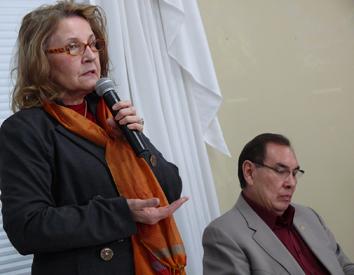By Chris Miller
B.C. Catholic
May 9, 2011
http://bcc.rcav.org/canadian/701-chris-miller
 |
| Marie Wilson and Chief Wilton Littlechild take part in a session of the Truth and Reconciliation Commission in St. Albert, Alta., May 2. |
EDMONTON (CCN)--Dating back to the 1870s, and through most of the 20th century, more than 150,000 first Nations, Metis and Inuit children were forcibly taken from their families and placed in Indian residential schools.
The federal government's aim was to "civilize," Christianize and assimilate aboriginal people into Canadian society.
Canada had more than 130 residential schools, the last of which closed in 1996. The policy behind the Church-run schools was to "kill the Indian in the child." Many students suffered emotional, physical or sexual abuse.
"We've heard stories as we've travelled from east to west about the experiences of students in residential schools," said Chief Wilton Littlechild, one of three commissioners with the Truth and Reconciliation Commission (TRC).
"We've heard some very sad and painful stories. We've heard very deep anger in some students. We've heard from parents and the pain that they suffered as a result of their children being taken away."
Littlechild and fellow commissioner Marie Wilson were at the Star of the North Retreat Centre in St. Albert May 2-3 to gather stories from Oblate priests and nuns who worked in the schools.
The TRC is tasked to research, gather information and educate Canadians about the history of the residential schools and its impact on aboriginal children. It is also mandated to guide reconciliation among aboriginal families, communities, churches, governments and Canadians.
The main sources of information on schools include archives and the experience of those connected to the schools.
Stories, testimonies
"We want your stories and testimonies so we can then inform Canada about the real history of residential schools," Littlechild told the Oblates and the sisters.
Almost without exception, the cases in which abuse happened at residential schools were in the context of abject poverty. Minimal needs such as warmth and food were used as enticements.
"As a society, what is the lesson that we might learn from this?" Wilson asked. "How long is it going to be acceptable in Canada that the vast majority of people living in poverty in Canada are First Nations and Inuit people? How long are we going to think as a country that this is a coincidence?"
Positive experiences
While the residential schools have often been labelled as a sad chapter in Canadian history, many positive experiences have been recorded too. Many former students have come forward with stories about their good education, school sports and long-lasting friendships.
Sister Dora Durand, a Grey Nun, served at the Blood Reserve residential school starting in 1954.
Fifty-seven years later, she still has strong relationships with many people there, including former students. She and one other Grey Nun cared for 73 little boys. Just as she loved her days in the convent, she believes most of the schoolboys enjoyed their school too.
"We worked for 24 hours. We went to bed at night, but if a kid cried during the night we had to get up," Sister Durand said. "I remember one year we had an epidemic of measles. The kids couldn't go out. They were all sick, high temperature, all in bed."
pails of soup
"We had to carry pails of soup upstairs for 73 sick little boys. The sisters worked very hard, and we loved those kids very much," said Sister Durand.
Her aim was to make them into good Christians, good citizens. As for punitive measures, she said a misbehaving student might be deprived of playing basketball or made to go to bed early. She witnessed no abuse.
Oblate Father Jacques Joly was also on the Blood Reserve for a year, not working at the school but serving as a missionary. He told the commissioners that he is not comfortable with the term "survivor" to describe all former students of the schools, given that many of them had positive school experiences.
Father Al Hubenig said that if former students are collectively called survivors, it leads one to believe all of the priests and nuns associated with the schools are perpetrators, which is definitely not the case.
"This makes it difficult for people who worked in a residential school to come forward because before they do, already they are branded perpetrators," said Father Hubenig.
In 2007, an out-of-court settlement was finalized. The Indian Residential School Settlement Agreement was the largest class action settlement in Canadian history. In compensation, common experience payments were made to anyone who attended a residential school. An independent assessment process ensures payment for all those students who experienced harm at those schools.
projects, grave markers
Money was allocated to the aboriginal healing foundation to support projects that promote healing. A total of $20 million was set aside for commemoration, funds that be used for school monuments, commemorative books or perhaps grave markers for students who never returned home alive from school.
The TRC has five years to report on its findings and make recommendations.
Any original material on these pages is copyright © BishopAccountability.org 2004. Reproduce freely with attribution.